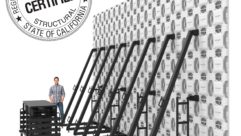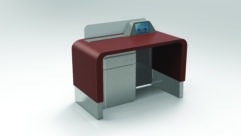
Technology Showcase: Lectern Microphones
Mar 1, 2004 12:00 PM,
By Allan Soifer
I started to prepare this Technology Showcase article about “podium” mics. So, I delved into my Merriam-Webster’s the other day and discovered that the term podium is really used to indicate a platform that the conductor of an orchestra would stand upon to be raised and visible to his or her musicians. What much of the A/V industry sometimes refers to as a podium is really a lectern: “a stand used to support a book or reading materials in a convenient position for a standing reader or public speaker; one from which scripture lessons are read in a church service.”
A pair of Microtech Gefell KEM 970s in use.
Well then, I’ll take the role of microphone evangelist and bring you some of the gospel about lectern mics for meeting rooms, lecture halls, distance learning environments, and even houses of worship. While some of this may be preaching to the choir, it’s valuable information to have when your client calls you for a replacement or an install for a brand new lectern. Similarly to boardroom and conference table setups, lectern mics come in two basic types: boundary mics and conventional directional mics. Boundary microphones are either omni or cardioid, and for our purposes, cardioid (unidirectional) is preferred. Fighting feedback from P.A. systems and stage monitors is a major consideration in podium miking, as is speech pickup from a user who may move slightly around the lectern during his or her delivery.
I should offer this caveat to the readership: Many of the consultants in this business are moving away from the use of boundary devices on lecterns, and current thinking advises caution when using boundary mics here. It is easy to inadvertently place scripts, binders and documents on top of the mic (because it is almost flat and not easily noticed), and the very nature of mounting a boundary mic can lead to thumps, bangs, and other disturbing noises. Some experts prefer using more conventional mics on lecterns. As always, this article is not an absolutely exhaustive list — I simply can’t cover every single model out there. Remember that some vendors repackage other manufacturers’ microphone elements, so it’s somewhat redundant to cite each and every cloned unit. I’ll hit the best of what’s out there, and the Web sites mentioned will give you an opportunity to check out the lines of microphones offered. The astute reader will note that some of these microphones are equally applicable to boardroom and similar uses. (For a look at boardroom mics, see the February 2003 issue.) Public speaking at a lectern and presentations/discussions around a boardroom table require similar mic features: high sensitivity, rejection of background noise, and ease of operation by nontechnical users. Unless noted otherwise, all the mics featured herein are condenser types.
MIC CHECK
Although Crown pioneered boundary microphones, the company recommends conventional miking for speech pickup on lecterns and has several models specifically designed for that purpose. In the standard mic line, the CM700 is an all-around cardioid mic, useful both in its mount and as a temporary handheld microphone. Crown’s LM201 is a rugged supercardioid condenser mic tailored for special-purpose use. The integral ball-and-socket mount offers easy positioning by the user. The tight forward pickup pattern of this instrument helps reject background noise and rumble and achieve greater gain before feedback. Gain structure is critical in lectern use, because many installs do not have a full-time operator or technician to ride levels. Anti-feedback filtering and automixers are excellent tools for that purpose, but a mic that is configured to offer better rejection from the rear and sides is a first-choice weapon in that battle.
Electro-Voice RE-90P 12-inch gooseneck

Electro-Voice offers two lines for lectern use: RE and PolarChoice. The RE-90P comes in 12- and 18-inch gooseneck models. These are ultraslim condenser mics with flexible necks to permit easy positioning. EV offers them as its basic workhorse for public speaking use. The PolarChoice line of lectern mics offers four selectable polar pickup patterns. These condenser mics are available in flange, flush, and in XLR-type mounts. The PC-Plus PolarChoice adds a programmable on/off/mute switch on the base. All are offered in both 12- and 18-inch styles. The wireless Polar Choice Satellite offers mobility and the clean look and convenience of no cables at the lectern.
Astatic makes several mics of the gooseneck/wand variety, which lend themselves well to lectern applications. The 827A has a controlled low-frequency roll-off and slightly peaked upper range to enhance speech qualities, while the 910, 915, and 920 microphones have a wide, flat frequency response which may provide a warmer sound when used close to source (close miking by the speaker). The model numbers refer to the same mic element, with 10, 15, and 20-inch goosenecks. Astatic offers a shockmount for lectern use, the GSM-1, which has an integral XLR connector to mate with these microphones.
Shure offers a wide range of microphones for use on lecterns and altars, and the company’s Web site is comprehensive. The Shure Microflex line is available in four models with a variety of heights and mounting styles to choose from. One model includes a silent mute switch with LED indicator, and they all feature interchangeable condenser microphone cartridges in cardioid, supercardioid, and omnidirectional polar patterns. The MX 412 and 418 are typical, and each mic comes with several mounting options, including locking or threaded flange mounts and shockmounting. The EZG gooseneck mics are for lectern use where quality and budget are both primary considerations, and they may be ordered with side-exit cablemount for use in temporary installations where the lectern cannot be custom-modified for permanent mounting. Of course, Shure also offers its line of boundary microphones and its conventional dynamic mics that are still found on many lecterns and reading stands as primary pickup instruments.
Clockaudio has several public speaking mic products of note. The C2 series of gooseneck-mounted condenser mics features cardioid or supercardioid patterns, and comes in eight models of various lengths from 8 to 20 inches. Clockaudio offers an interesting short gooseneck mic, the C3100, with the SM20 shockmount. This microphone uses a miniature 3-pin connecter (Tiny-Q) for quick detachability. These shorter gooseneck stylings are becoming popular when video or photo coverage of a speaker may be needed. The short flexible neck tends to keep the mic out of the speaker’s face when photographed from most angles. A series of dynamic gooseneck mics for lecterns, the D33, D34, and D43/44, is also available when lower sensitivity and greater ruggedness are mandated.
Sennheiser offers the Contractor Mic Kit (reviewed in
Sound & Video Contractor
‘s December 2003 issue). The kit consists of three gooseneck options — the MZH 3015, the MZH 3040, and the MZH 3042 — and three mic capsules of different polar patterns. The ME 34 is a cardioid, the ME 35 is a supercardioid, and the ME 36 is a supercardioid/lobar. These options provide a quality solution to practically any situation that might arise.
Beyerdynamic has a range of models for lectern use with an array of options for mounting and specialized needs. Its SHM 203A series offers varying lengths of gooseneck tubes and flange, XR, and Nextel-plug (similar to a phone plug) mounting. Some models may be ordered with an illuminated red plastic ring for interfacing with a conferencing system in which the live mic is visually identified. The SHM 803A features the same variety of mounts and styles, with a shotgun mic capsule. Hypercardioid mics like the shotguns were first used in the broadcast and entertainment fields for voice pickup with the mic out of camera range. This tightly focused long-reach pattern has found acceptance in the specialized field of presentation microphones, in which a speaker may stand too far from a conventional microphone for adequate levels above ambient noise. Beyerdynamic also has the SHM 424-11, which may be lectern installed as a permanently mounted microphone for less demanding applications.
Schoeps is a German microphone maker. Primarily a supplier to the recording studio and motion picture industry, it markets several mics suitable for lectern and table use. These include the S 250 gooseneck series, as well as accessory mounting tubes for their interchangeable mic capsules, and the RL and RLG series, for tabletop and lectern use.
Audio-Technica AT 857 Ama

Audio-Technica has two primary lines of lectern-type microphones, goosenecks and rigid tubes. Its AT 857AMa is typical of flexible tubed mics: about 12-inch flexible neck, cardioid capsule, multiple mounting options, and other versions with longer tubes. An example of Audio-Technica’s rigid-tube line would be the ES 905C, which is about 16 inches long and very slim. Both these types come with a base that must be mounted on the lectern. The company’s Pro series, as in the PRO 49Q, consists of gooseneck microphones designed to plug in to standard XLR fittings, either socket mount or cable end.
AKG offers various mic capsules for podium use, and some models can be fitted to gooseneck adapters for lectern and tabletop use. The Discreet Acoustics Modular Series, including the CK 31, 32, 33, 47, and 80, features five types of capsules and six installation modules. AKG also markets the hypercardioid C 747. There are dozens of variations and combinations that can be selected, depending on both the electronic specs and the budget needs of a given install.
Audix is a manufacturer that recordists and musicians have adopted as a must-have, alongside the older studio favorites. In the Contractor mic series, the ADX 112 and ADX 118 are the company’s cardioid and hypercardioid lectern mics. Both models feature a rigid tube at the upper portion of the assembly, with the flexible neck near the mounting base. The MICROS series comprises two small condenser mics, the M1245 and the M1290. These can be attached to an accessory gooseneck for a high-quality podium mic.
Neumann KM 100

Neumann’s KM 100 series modular design features seven interchangeable capsules; the AK 30 diffuse-field equalized omnidirectional, the AK 31 free-field equalized omnidirectional, the AK 20 figure-8, the AK 40 cardioid, the AK 43 wide cardioid, the AK 45 cardioid with bass roll-off, and the AK 50 hypercardioid.Microtech Gefell has probably the single most expensive microphone featured in this article. The KEM 970 (reviewed in Sound & Video Contractor‘s November 2003 issue) brings line array technology to the input side. Comprising eight mic elements aligned in a vertical tubular housing, this microphone provides well-defined pattern control (30 degrees vertical and 120 degrees horizontal) similar to a line array loudspeaker system. Although its list price of $8,500 could be a bit daunting, this microphone deserves consideration for any high-quality lectern application.DPA’s (Danish Pro Audio) Compact microphones provide a number of mic elements and mounting solutions for lectern applications. The company’s 4023 cardioid mic combined with the 400 mm CAPO Compact Active Pole is just one of many possible variations. Drawing from its Bruel and Kjaer lineage of measurement microphones, DPA has expanded the line with an extensive selection of products and accessories for recording, live, and broadcast applications.Finally, Peavey offers the PM 16S lectern application microphone. It’s the only specific mic for this use, and it features a cardioid pattern and a collet-type mounting flange with mechanical isolation to reduce the thump-and-boom of presenters moving their manuscripts and materials around on the lectern. Peavey makes a boundary microphone, the PSM 2, as well.NOW SPEAKINGLectern microphone technology has improved vastly since the days of hastily placing a conventional mic on a table stand somewhere on top of the reading desk. Proper assessment of the acoustical environment and the intended use of the mics is critical to a successful installation with satisfied clients. With such a large variety of microphones and mounting options, it is possible to serve any need — from prestigious corporate presentation rooms finished in costly veneers to ornate reading desks in houses of worship to utilitarian lecterns in hotel function rooms and high school auditoriums. This is a niche area of audio contracting service that has been less than well served in the past, and the means to offer client satisfaction are now plentiful and easily obtained.Allan Soiferis a recordist, broadcast consultant, and a regular adviser to several Canadian governmental groups in the areas of audio, video, and interpretation/conferencing support. He can be reached at[email protected].For More InformationAKG Acoustics
www.akg-acoustics.comAstatic
www.astatic.comAudio-Technica
www.audiotechnica.comAudix
www.audixusa.combeyerdynamic
www.beyerdynamic.comClockAudio
www.microphones-audio.comCrown Audio
www.crownaudio.comDPA Microphones
www.dpamicrophones.comElectro-Voice
www.electrovoice.comMicroTech Gefell
www.gefell-mics.comNeumann
www.neumannusa.comPeavey
www.peavey.comSchoeps
www.schoeps.deSennheiser
www.sennheiser.comShure
www.shure.com










